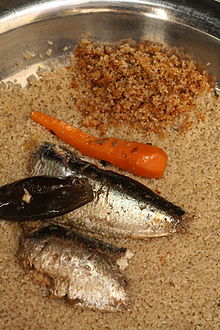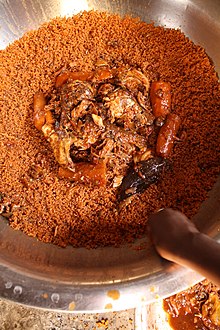
Jambalaya is a savory rice dish of mixed origins that developed in the U.S. state of Louisiana apparently with African, Spanish, and French influences, consisting mainly of meat or seafood, and vegetables mixed with rice and spices.

Egg foo young is an omelette dish found in Chinese cuisine. The name comes from the Cantonese language. Egg foo young is derived from fu yung egg slices, a mainland Chinese recipe from Guangdong.

Mexican rice, also known as arroz a la mexicana, arroz mexicano, sopa de arroz, or arroz rojo in Spanish, is a Mexican side dish made from white rice, tomato, garlic, onion, and perhaps other ingredients. Mexican rice is almost always eaten as a complement to other dishes such as mole, refried beans, rotisserie chicken, carne asada, picadillo, tacos, fried fish, fried chicken, chiles rellenos, or vegetable soup.

Salvadoran cuisine is a style of cooking derived from the nation of El Salvador. The indigenous foods consist of a mix of Amerindian cuisine from groups such as the Lenca, Pipil, Maya Poqomam, Maya Chʼortiʼ, Alaguilac and Cacaopera peoples. Many of the dishes are made with maize (corn). There is also heavy use of pork and seafood. European ingredients were incorporated after the Spanish conquest.

Jollof, or jollofrice, is a rice dish from West Africa. The dish is typically made with long-grain rice, tomatoes, chilies, onions, spices, and sometimes other vegetables and/or meat in a single pot, although its ingredients and preparation methods vary across different regions. The dish's origins are traced to Senegal.

Ghanaian cuisine refers to the meals of the Ghanaian people. The main dishes of Ghana are centered around starchy staple foods, accompanied by either sauce or soup as well as a source of protein. The primary ingredients for the vast majority of soups and stews are tomatoes, hot peppers, and onions. As a result of these main ingredients, most Ghanaian soups and stews appear red or orange.

The cuisine of Senegal is a West African cuisine that derives from the nation's many ethnic groups, the largest being the Wolof. Islam, which first embraced the region in the 11th century, also plays a role in the cuisine. Senegal was a colony of France until 1960. From the time of its colonization, emigrants have brought Senegalese cuisine to many other regions.

Peanut stew or groundnut stew, also known as maafe, sauce d'arachide (French) or tigadèguèna is a stew that is a staple food in Western Africa. While maafe is a dish from Senegal, tigadèguèna originates from the Mandinka and Bambara people of Mali.

West African cuisine encompasses a diverse range of foods that are split between its 16 countries. In West Africa, many families grow and raise their own food, and within each there is a division of labor. Indigenous foods consist of a number of plant species and animals, and are important to those whose lifestyle depends on farming and hunting.

Nigerian cuisine consists of dishes or food items from the hundreds of Native African ethnic groups that comprises Nigeria. Like other West African cuisines, it uses spices and herbs with palm oil or groundnut oil to create deeply flavored sauces and soups.

Burkinabé cuisine, the cuisine of Burkina Faso, is similar to the cuisines in many parts of West Africa, and is based on staple foods of sorghum, millet, rice, fonio, maize, peanuts, potatoes, beans, yams and okra. Rice, maize and millet are the most commonly eaten grains. Grilled meat is common, particularly mutton, goat, beef and fish.

Charleston red rice or Savannah red rice is a rice dish commonly found along the Southeastern coastal regions of Georgia and South Carolina, known simply as red rice by natives of the region.

Szczecin paprikash, also known as Polish paprikash, is a Polish canned fish spread made from ground fish, rice, tomato paste and vegetable oil, seasoned with onion, salt and spices. It has the form of a reddish-brown paste with visible rice grains. The recipe, inspired by a West African dish sampled by Polish fishermen, was developed in the 1960s at a state-owned far-sea fishing and fish processing company based in the port city of Szczecin, in northwestern Poland. It is a popular snack, especially with students, and remains a symbol of Szczecin's local identity.

Ivorian cuisine is the traditional cuisine of Côte d'Ivoire, or the Ivory Coast, and is based on tubers, grains, pig, chicken, seafood, fish, fresh fruits, vegetables and spices. It is very similar to that of neighboring countries in West Africa. Common staple foods include grains and tubers. Côte d'Ivoire is one of the largest cocoa producers in the world and also produces palm oil and coffee.

Angolan cuisine has many dishes popular among nationals and foreigners, including funge, mufete, calulu, moamba de galinha, moamba de ginguba, kissaca, and mukua sorbet.

Gambian cuisine is part of West African cuisine and includes the culinary practices and traditions of the nation of The Gambia. Common ingredients include fish, rice, peanuts, tomato, black-eyed peas, lemon, cassava, cabbage, salt, pepper, onion, chili, and various herbs. Oysters are also a popular food from the River Gambia, and are harvested by women.

Guinean cuisine includes traditional Guinean dishes such as fou fou, boiled mango, fried plantains, patates and pumpkin pie.

The cuisine of Mauritania includes the culinary practices of Mauritania. Historically, what is now Mauritania has been influenced by Arab, Berbers and African peoples who have lived in and traversed the "stark" landscape marked with Sahara desert dunes in caravans. There is an overlap with Moroccan cuisine in the north and Senegalese cuisine in the south.

Riz gras or riz au gras is a rice-based dish in Beninese, Burkinabé, Guinean, Ivorian, and Togolese cuisines, in West Africa. It is also prepared in other African countries, such as Senegal, where it is called tiebou djen and is prepared with significant amounts of fish and meat. This dish can be considered a variation of what is known as Jollof rice in English-speaking West Africa.

Okoy or ukoy, are Filipino crispy deep-fried fritters made with glutinous rice batter, unshelled small shrimp, and various vegetables, including calabaza, sweet potato, cassava, mung bean sprouts, scallions and julienned carrots, onions, and green papaya. They are traditionally served with vinegar-based dipping sauces. They are eaten on their own or with white rice. They are popular for breakfast, snacks, or appetizers. Okoy are sometimes dyed bright orange with achuete seeds.






















